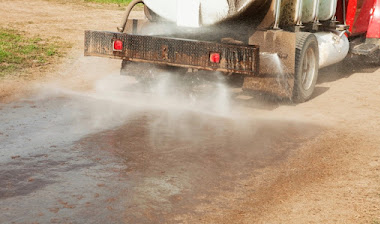
Latest Penn State Report On Environmental Impact Of Road Dumping Drilling Wastewater Will Have ‘Immediate,’ ‘Large,’ ‘Intense’ Impact
April 29, 2022Study Links Fracking, Drinking Water Pollution, and Infant Health
May 3, 2022By Justin Nobel, DeSmog, April 25, 2002
This article is about radiation in drilling waste being discarded in ways that are environmentally harmful and dangerous to human health. It has implications in NY State, where radioactive cuttings with liquids are being disposed of into landfills and illegal road dumping is occurring. It also has implications in PA, where there is roadway and landfill disposal of radioactive drilling wastes.
Activists and scientists have found alarming levels of radioactivity in samples collected along the road and soils outside Austin Master Services, an oilfield waste processing facility with a history of sloppy practices in eastern Ohio. The facility is located just down the street from a high school football stadium and less than 1,000 feet from a set of city drinking water wells, raising public health concerns from a nuclear forensics scientist about the extent of possible radioactive contamination.
Last November, members of two advocacy groups, Concerned Ohio River Residents and Mountain Watershed Association, collected soil samples from outside the Martins Ferry, Ohio facility of Austin Master Services, a Pottstown, Pennsylvania-based company that operates in 10 states. Both groups are concerned about the handling of radioactive oilfield waste in their region, which has seen over a decade of intensive fracking development in the Marcellus and Utica shale formations.
All of that oil and gas drilling produces huge volumes of liquid and solid waste that need treatment and disposal. Oilfield waste service companies pick it up directly at the wellhead, and sometimes perform an initial processing, before bringing some of it to facilities like Austin Master’s for additional treatment. But how well-prepared such companies are to handle the industry’s radioactive waste is being increasingly called into question. For instance, a DeSmog investigation has revealed that railcars carrying radioactive oilfield waste from Austin Master in Martins Ferry have arrived leaking at a final disposal facility in Utah on multiple occasions between 2015 and 2020. Over the years, conditions at Austin Master have raised concerns from inspectors and advocacy groups alike.
James Cato, with the southwestern Pennsylvania-based environmental advocacy group, Mountain Watershed Association, recalls the day he and other volunteers first took soil samples on the public roadway near the Ohio oilfield waste facility.
“It was a bright cloudless morning but the dirt road to Austin Masters was hazy with dust stirred up from truck traffic,” says Cato. “Between [Austin Master] and the nearby asphalt plant, a sour scent clung to everything and dust buffeted our goggles and protective masks whenever a waste truck blew by.” He added that their radiation detector’s activity was especially notable in this location, emitting “near constant rapid beeping.”
The Ohio and Pennsylvania advocacy groups sent the Austin Master samples to Marco Kaltofen, a nuclear forensics scientist in Massachusetts who has extensive experience examining radioactive waste from the nuclear weapons, nuclear power generation, and oil and gas industries. Before the activists gathered the samples, Kaltofen advised them on appropriately handling and shipping the potentially radioactive samples. After reviewing them, he then sent the samples to Eberline Analytical, a radiological analysis lab in Oak Ridge, Tennessee.
The relatively high levels of radioactivity in the results, returned in February, immediately caught Kaltofen’s attention. “This needs to be fixed,” he says. They found levels of radium-226 at 14.1 picocuries per gram, and radium-228 at 3.7 picocuries per gram.
Radium is one of several naturally occurring radioactive elements well-known to occur in oilfield waste. Soil nationwide generally has a radium background level of about 1 picocurie per gram, and the U.S. Environmental Protection Agency (EPA) limit for topsoil at uranium mills and Superfund toxic waste dumps is 5 picocuries per gram above background levels. The samples analyzed by Eberline also showed elevated levels of radioactive forms of lead and thorium.
“This is an impressive source of contamination. These numbers are well above background and excessive,” says Kaltofen. “I have very grave concern about the accidental inhalation and ingestion of these particles. My concern here is wind is going to move this out into the neighborhood.” The radioactive dust and soil may settle in yards where children play, he says, and kids tend to dig around in grass and dirt, and then touch their fingers to their mouths.
This is especially worrisome, according to Kaltofen, because radium is considered a “bone-seeker.” If accidentally inhaled or ingested, the radioactive element tends to accumulate in the bones, where it continues emitting radiation and can lead to cancer. “Radium 226 is a potent source of radiation exposure, both internal and external,” notes a 1982 report that discusses oilfield radioactivity hazards and was produced by the American Petroleum Institute’s Department of Medicine and Biology’s Committee for Environmental Biology and Community Health.
Although the EPA does not regulate oilfield radioactivity, it does have a web page with information on the topic. “Maintenance workers include those who work directly on top of uncovered waste sites,” the EPA page states. “Potential risks assessed for these workers include inhalation of radioactive dust.” Risks for members of the public working or residing within roughly 100 yards of a disposal site are very low, continues EPA, but include, “Inhalation of contaminated dust,” “Ingestion of contaminated well water,” “Ingestion of food contaminated by well water,” and “Ingestion of food contaminated by dust deposition.”
Kaltofen explained that any time oilfield waste is moved around in piles at a processing facility such as Austin Master, dust is inevitably created. Even if the waste is wet, it will eventually dry and create dust, and this dust would invariably have some of the radioactive elements common to oilfield waste attached, such as radium. He added that the buildup of radioactive elements common to oilfield waste directly in front of a facility processing copious amounts of oilfield waste points to Austin Master as the likely source.
After receiving the initial round of concerning results near Austin Master in February, Concerned Ohio River Residents (CORR) sent the Eberline lab a second batch of samples taken along the public roadway adjacent to the Martins Ferry facility and also a nearby city park and cemetery. Results showed an increase in radioactivity closer to the facility.
For example, levels of radium-226 recorded at the park, just over a mile from the facility, and the cemetery, just over half a mile, fell around average soil background levels or just above them. But levels taken along the road to Austin Master ticked up from 3.76 picocuries per gram, about 900 feet from the facility’s main entrance, to 14.66 picocuries per gram less than 150 feet from the entrance. Based on the path of samples taken by members of CORR, a growing trail of radioactivity leads to Austin Master’s door.
Austin Master Services has authorization with the state of Ohio to annually receive 120 million pounds of radioactive oilfield waste. Despite the dangers this type of waste poses, a 1980 federal exemption has deemed it to be non-hazardous and therefore exempt from federal rules that would otherwise apply to hazardous waste.
On April 4, Concerned Ohio River Residents held a press event in Martins Ferry and demanded that state officials issue orders to immediately stop work at the Austin Master facility due to public health and environmental concerns. The group also requested that the EPA perform an inspection of the entire facility, and has said it will push for the plant to become a Superfund site, an official designation reserved for massively contaminated lands and environmental emergencies that would make funds available for cleanup. EPA has not replied to questions regarding these requests.
“We want them to invoke their law and do their own testing of the whole entire area,” Beverly Reed, an Ohio Valley business owner and member of Concerned Ohio River Residents, stated at the press event.
We want the site cleaned up and properly monitored, Reed continued, before the situation becomes “a crisis.”
Chris Martin, a spokesperson for Austin Master, has not replied to a request for comment regarding Concerned Ohio River Residents’ sampling results.
Oilfield Waste: A Long Arc of Documented Contamination in Fracking Country
Oil and gas development generates several voluminous waste streams, both liquid and solid. The radioactive signature of oilfield waste has been acknowledged by the oil and gas industry for decades, well before the advent of modern fracking in the 1990s and early 2000s. And research by the U.S. Geological Survey indicates that oilfield waste generated in the Marcellus and Utica has particularly high radioactivity levels, leading to “the potential for surface and aqueous radium hazards if not properly disposed of.”




